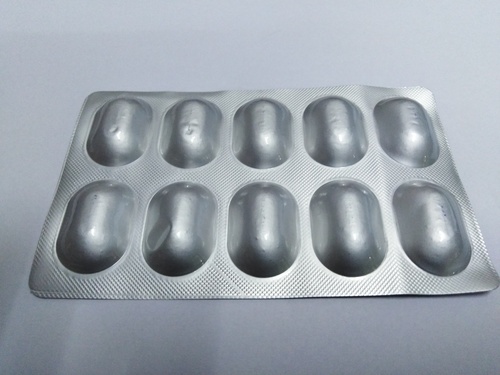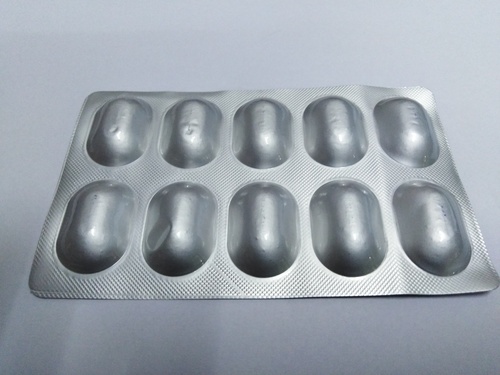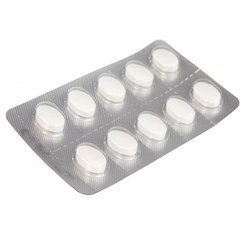Cefpodoxime and Clavulanic acid combination are effective against multiple infections. The pharmacological action of Clavulanic acid prevents hydrolysis of Cefpodoxime against beta-lactamase secreting microbes and increases the antibiotic spectrum.
Cefpodoxime, an antibiotic belongs to class of third-generation cephalosporins, is indicated for the treatment of systemic infections including respiratory tract infections, urinary tract infections, otitis media, skin infections and uncomplicated gonorrhoea due to Gram-positive and Gram-negative organisms.
Cefpodoxime + Clavulanic Acid |
| |
| |
| |
Combinations of Cefpodoxime + Clavulanic Acid
|
- Cefpodoxime 200 mg. & Clavulanic Acid 125 mg. Tablets
- Cefpodoxime 100 mg. & Clavulanic Acid 62.5 mg. Tablets
- Cefpodoxime 50 mg. & Clavulanic Acid 31.25 mg. Tablets
- Cefpodoxime 50 mg. & Clavulanic Acid 31.25 mg. per 5 ml. Dry Syrup
|
| |
| Cefpodoxime 200mg + Clavulanic Acid 125 mg: A Combination of Cefpodoxime (third generation oral cephalosporin) and a beta lactamase inhibitor, Clavulanic Acid, used for the treatment of urinary tract infections, pneumonia, bronchitis, gonorrhea, and multiple other infections (see INDICATIONS). |
| |
| EXECUTIVE SUMMARY | | Drug Name | Cefpodoxime + Clavulanic Acid | | Mechanism of Action | Cefpodoxime: Inhibition of cell wall synthesis
Clavulanic Acid: Enzyme inhibitor that enhances the antibacterial activity | | Indication | Multiple Infections (see INDICATIONS) | | Form | Tablets (Cefpodoxime/Clavulanic Acid): 200 mg/125 mg Tablets (Cefpodoxime/Clavulanic Acid): 100 mg/62.5 mg
Dry Syrup (Cefpodoxime/Clavulanic Acid): 100 mg/62.5 mg
Dry Syrup (Cefpodoxime/Clavulanic Acid): 50 mg/32.25 mg
| |
| |
CONTENTS - Mechanism of Action
- Indications
- Dosage
- Highlights
- Microbiology
- Pharmacokinetics
- Clinical Trial Summary
- Warnings / Precautions
- Special Population
- Adverse Events
- References
|
| |
| MECHANISM OF ACTION1,2:
Cefpodoxime, a third generation semi-synthetic cephalosporin, exhibits activity against several Gram positive as well as Gram negative microorganisms. This compound is also stable in beta lactamase environment. Cefpodoxime exhibits exceptional activity against methicillin susceptible Staphylococci, Streptococcus pneumoniae, Haemophilus influenzae, Nesseria spp, and Moxaxella catarrhalis, which are referred as the most common hospital acquired and community acquired infections.
Clavulanic acid is a natural inhibitor of beta lactamase, which are produced by Streptomyces clavuligerus. It binds to beta lactamase moieties and inactivates them, thus restricting the cefpodoxime destruction. Clavulanic acid has very little antimicrobial activity.
INDICATIONS1,2:
Cefpodoxime-Clav is indicated in the following infections when caused by susceptible organisms - Acute bacterial exacerbations of chronic bronchitis
- Acute community acquired Pneumonia
- Upper and lower respiratory tract infections
- Skin and soft tissue infections
- Urinary tract infections
- Pharyngitis and/or tonsillitis
- General gonorrhea (men and women) and rectal gonococcal infections (women)
- Acute maxillary sinusitis
|
| |
| DOSAGE1,2: |
| |
| TABLE 1: Cefpodoxime Dosage Schedule for Adults (Age 12 years and older) |
| |
| Type of Infection | Total Daily Dosage | Dosage Frequency | Duration | | Pharyngitis and/or tonsillitis | 200 mg | 100 mg Q 12 hrs | 5 to 10 days | | Acute community acquired Pneumonia | 400 mg | 200 mg Q 12 hrs | 14 days | | Acute bacterial exacerbations of chronic bronchitis | 400 mg | 200 mg | Q 12 hrs10 days | Uncomplicated gonorrhea (men and women) and
rectal gonococcal infections (women) | 200 mg | Single dose | | | Skin and skin structure | 800 mg | 400 mg Q 12 hrs | 7 to 14 days | | Acute maxillary sinusitis | 400 mg | 200 mg Q 12 hrs | 10 days | | Uncomplicated urinary tract infection | 200 mg | 100 mg Q 12 hrs | 7 days | |
| |
| TABLE 2: Cefpodoxime Pediatric Dosage Schedule |
| |
| Type of Infection | Total Daily Dosage | Dosage Frequency | Duration | | Pharyngitis and/or tonsillitis | 200 mg | 100 mg Q 12 hrs | 5 to 10 days | | Acute community acquired Pneumonia | 400 mg | 200 mg Q 12 hrs | 14 days | | Acute bacterial exacerbations of chronic bronchitis | 400 mg | 200 mg | Q 12 hrs10 days | Uncomplicated gonorrhea (men and women) and
rectal gonococcal infections (women) | 200 mg | Single dose | | | Skin and skin structure | 800 mg | 400 mg Q 12 hrs | 7 to 14 days | | Uncomplicated urinary tract infection | 200 mg | 100 mg Q 12 hrs | 7 days | | Acute maxillary sinusitis | 400 mg | 200 mg Q 12 hrs | 10 days | |
| |
| Special population:
Patients with Renal Dysfunction
For patients with severe renal impairment (< 30 mL/min creatinine clearance), the dosing intervals should be increased to Q 24 hours. In patients maintained on hemodialysis, the dose frequency should be 3 times/week after hemodialysis.
Patients with Cirrhosis
Cefpodoxime pharmacokinetics in cirrhotic patients (with or without ascites) are similar to those in healthy subjects. Dose adjustment is not necessary in this population. |
| |
| HIGHLIGHTS4: | | Cefpodoxime-Clav is a combination of two drugs and is effectoive against multiple infection types. | | Clavulanic acid component protects degeneration of cefpodoxime in presence of -lactamase enzymes, and increases the antibiotic spectrum. | | Clavulanic acid in Cefpodoxime-Clav, prevents the resistance to Cefpodoxime that may increase with continuous usage of the drug | | Cefpodoxime-Clav has shown effectiveness against multiple Gram-positive and Gram-negative bacteria | | Cefpodoxime is generally well tolerated | |
| |
| HIGHLIGHTS4:
Cefpodoxime
Cefpodoxime has shown efficacy against most strains of the following microorganisms, both in vitro and in clinical infections.
Gram-positive Aerobes:
Staphylococcus aureus (including penicillinase-producing strains)
Staphylococcus saprophyticus
Streptococcus pneumoniae (excluding penicillin resistant strains)
Streptococcus pyogenes
NOTE: Cefpodoxime is inactive against methicillin-resistant staphylococci
Aerobic Gram-negative Microorganisms:
Escherichia coli
Klebsiella pneumoniae
Proteus mirabilis
Haemophilius influenzae (including beta lactamase strains)
Moraxella (Branhmella) catarrhalis
Nesseria gonorrhoeae (including penicillinase-producing strains)
The following in vitro data are available, but their clinical significance is unknown. Cefpodoxime exhibits in vitro minimum inhibitory concentrations (MICs) of 2.0 mcg/mL against most (90%) of isolates of the following microorganisms. However, the safety and efficacy of cefpodoxime in treating clinical infections due to these microorganisms have not been established in adequate and well-controlled clinical trials.
Aerobic Gram-positive Microorganisms:
Streptococcus agalactiae
Streptococcus spp. (Groups C, F, G)
NOTE: Cefpodoxime is inactive against enterococci.
Aerobic Gram-negative Microorganisms:
Citrobacter diversus
Klebsiella oxytoca
Proteus vulgaris
Providencia rettgeri
Haemophilus parainfluenzae
NOTE: Cefpodoxime is inactive against most strains of Pseudomonas and Enterobacter
Anaerobic Gram-positive Microorganisms:
Peptostreptococcus magnus
Clavulanic Acid
Clavulanic acid is a fermentation product of Streptomyces clavuligerus, and a beta-lactam compound with penicillin like structure. It has the capability to inactivate a broad spectrum of betalactamases through blocking their active sites. Clavulanic acid is specifically active against the clinically important plasmid-mediated beta-lactamases.
CLINICAL TRIAL SUMMARY1,6:
Cefpodoxime, a relatively new broad-spectrum third-generation cephalosporin, has very good in vitro activity against Enterobacteriaceae, Hemophilus spp. and Moraxella spp., including -lactamase producers and many strains resistant to other oral agents. It also has activity against Gram-positive bacteria, especially against streptococci.
Cefpodoxime, which possesses characteristics of the third-generation cephalosporins, has been investigated in large numbers of patients with upper and lower respiratory tract infections, urinary tract infections (UTIs), or skin and soft tissue infections (SSTIs).
The international clinical experience with this drug has confirmed its efficacy in treating pharyngotonsillitis with 97% to 100% success rates in adults, and 92% to 100% in pediatric patients. In lower respiratory tract infections, cefpodoxime has proven efficacious in bronchial infections (84% to 97% success rate), and in bacterial pneumonia (favorable outcome in 81.8% to 100% of cases). In UTIs, SSTIs, and pediatric infections a more limited experience has provided favorable results, with an efficacy rate ranging from 77% to 95% of cases.
MICROBIOLOGY3,9:
Cefpodoxime
Cefpodoxime has shown efficacy against most strains of the following microorganisms, both in vitro and in clinical infections.
PHARMACOKINETICS1,4,7,8:
Cefpodoxime
Bioavailability of cefpodoxime is 50% in fasting subjects and it increases in presence of food. Peak plasma concentration of Cefpodoxime 200 mg single dose is 2.18 mcg/ml.
The Drug is well distributed after oral administration. Cefpodoxime reaches therapeutic concentrations in respiratory tract and genito-urinary tracts and bile. Protein binding of cefpodoxime ranges from 20 to 30 %. The plasma half life of cefpodoxime is about 2 to 3 hours and is prolonged in patients with impaired renal function. Cefpodoxime is excreted unchanged in urine. |
| |
| TABLE 31: The Pharmacokinetics of Cefpodoxime in Adult Patients |
| |
| Cefpodoxime Plasma Levels (mcg/ml) in Fasted Adults After Cefpodoxime Proxetil Administration (Single Dose) | Dose
(Cefpodoxime equivalents) | Time After Oral Ingestion | | 1hr | 2hr | 3hr | 4hr | 6hr | 8hr | 12hr | | 100 mg | 0.98 | 1.4 | 1.3 | 1 | 0.59 | 0.29 | 0.08 | | 200 mg | 1.5 | 2.2 | 2.2 | 1.8 | 1.2 | 0.62 | 0.18 | | 400 mg | 2.2 | 3.7 | 3.8 | 3.3 | 2.3 | 1.3 | 0.38 | |
| |
| Pharmacokinetics in Elderly Subjects
Elderly subjects did not require dosage adjustments unless they had diminished renal function.
Clavulanic Acid
Clavulanic acid is well absorbed after oral administration. Peak plasma concentration of Clavulanic acid 125 mg single dose is 2.2 mcg/ml. It is distributed completely after oral administration. Protein binding of clavulanic acid is about 30 %.The plasma half life of clavulanic acid is one hour.
About 60 % of clavulanic acid is excreted unchanged in urine. The clavulanic acid component in the drug combination protects cefpodoxime from degradation by -lactamase enzymes, and effectively extends the antibiotic spectrum of cefpodoxime to include many bacteria that are normally resistant to cefpodoxime and other lactam antibiotics.
WARNINGS and PRECAUTIONS1,2
Cross hypersensitivity in penicillin sensitive patients, leading to serious acute hypersensitivity reactions may need treatment with epinephrine along with other emergency measures such as intravenous fluids, oxygen, airway management, and intravenous antihistamine, as clinically indicated.
Clostridium difficile associated diarrhea (CDAD) has been reported with use of nearly all antimicrobial agents, including cefpodoxime tablets, and may range in severity from mild diarrhea to fatal colitis. If CDAD is suspected or confirmed, ongoing antibiotic use not directed against C. difficile may need to be discontinued. Appropriate fluid and electrolyte management, protein supplementation, antibiotic treatment of C. difficile, and surgical evaluation should be instituted, as clinically indicated.
In patients with transient or persistent reduction in urinary output due to renal insufficiency, the total daily dose of cefpodoxime should be reduced because high and prolonged serum antibiotic concentrations can occur in such individuals following usual doses. Cefpodoxime, like other cephalosporins, should be administered with caution to patients receiving concurrent treatment with potent diuretics.
As with other antibiotics, prolonged use of cefpodoxime may result in overgrowth of non-susceptible organisms. Repeated evaluation of the patients condition is essential. If superinfection occurs during therapy, appropriate measures should be taken.
SPECIAL POPULATION1,2
Nursing Mothers
Cefpodoxime is excreted in human milk, so a decision should be made whether to discontinue nursing or to discontinue the drug, taking into account the importance of the drug to the mother.
Pediatric Use
Safety and efficacy in infants less than 2 months of age have not been established.
Geriatric Use
Dose adjustment in elderly patients with normal renal function is not necessary.
ADVERSE EVENTS1
Cefpodoxime
Incidence greater than 1% include #Diarrhea: 7%; Nausea: 3.3%; Vaginal Fungal Infections:1%; Vulvovaginal Infections:1.3%; Abdominal Pain: 1.2%; and Headache:1%
Number of diarrhea or loose stools were dose related: decreasing from 10.4% of patients receiving 800 mg per day to 5.7% for those receiving 200 mg per day. Of patients with diarrhea, 10% had C. difficile organism or toxin in the stool.
Other adverse events consists of difficulty breathing or swallowing, Hives, Itching, Mild skin rash, Painful mouth or throat sores, Severe skin rash, Sore throat, Unusual bleeding or bruising, Upset stomach, Vaginal infection, Vomiting, and Wheezing.
Clavulanic Acid
Side effects include bloody diarrhea, bloody urine, painful or difficult urination, unusual weakness, easy bleeding and bruising, confusion, dry mouth, increased urination, chills, body aches, fever, sore throat, headache, seizures, chest pain and irregular heartbeat. These side effects are very rare and do not affect a large amount of users. Treatment should not normally exceed 14 days.
|



 Send Inquiry
Send Inquiry


